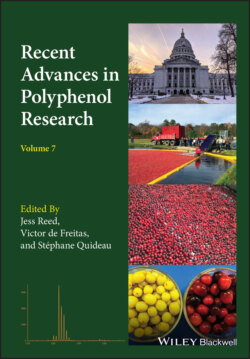Читать книгу Recent Advances in Polyphenol Research - Группа авторов - Страница 53
3.5.4 Antidiabetic Mechanisms of Wild Tundra Berries
ОглавлениеWild berries have traditionally been integral dietary components for Native Americans and Alaska Natives, are used ceremonially and medicinally, and remain a treasured resource today (Burns Kraft et al. 2008; Kellogg et al. 2010). In Alaska and northern Canadian territories, lands with a high proportion of indigenous people, wild berry species often are the only edible terrestrial plants endemic to the environments. Site‐specific variation in anthocyanin and proanthocyanidin levels in these wild berries, and more concentrated phytoactive constituents in the more spartan, high‐stress environments of the arctic have been documented. Initial on‐site mobile bioassays conducted with Alaska Natives identified a wealth of primary bioactivities relevant to human health, including higher antioxidant potentials (relative to commercially harvested domestic berries), more concentrated and diverse phytochemical profiles, and significant effects of climatic fluctuations on berry abundance and quality. The strong partnerships forged in workshops that put scientific inquiry in the context of traditional knowledge (Flint et al. 2011) were followed by more extensive laboratory bioassays of wild berry species.
The incredibly diverse phenolic profiles of wild tundra berries (Figure 3.4), in particular, were found to include abundant A‐type proanthocyanidins, and were linked to the berries’ efficacy against diabetes and metabolic syndrome biomarkers, including expression of preadipocyte factor 1. Berry‐derived flavonoids and, more specifically, their gut‐derived phenolic microbial metabolites have demonstrated efficacy in modulation of serum glucose levels (Grace et al. 2009; Kellogg et al. 2010), in neuroprotective properties (Gustafson et al. 2012; Lila et al. 2014), and in wound healing and other anti‐inflammatory bioactivities (Grace et al. 2014; Nieman et al. 2018; Esposito et al. 2019; Nieman et al. 2019).
Figure 3.4 (a) Wild Vaccinium uliginosum (bog blueberry) growing on the Alaskan tundra. (b) Representative anthocyanins from Alaskan berries. (c) Proanthocyanidin A‐type structure characteristic of many Alaskan berry genotypes.
Source: (a) Mary Ann Lila.
